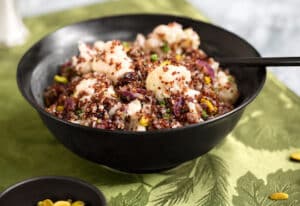This naturally sweet powder is ground from the pods of the evergreen carob tree. In the past, carob was once known as locust bean or Saint-John’s-Bread. Saint John the Baptist is said to have survived in the wilderness by eating carob pods and wild honey. Carob is most commonly used as a substitute for cocoa due to the similarity of color, texture, and cooking properties. Does it really taste like chocolate? Opinions vary, but it’s hard to deny that it is at least similar.
Commonly sold in vacuum-packed cans in natural-food stores, carob may less frequently be sold in bulk. Store carob in a tightly lidded container in a cool, dry place. It will last for at least a year if kept free of moisture. Carob is often an ingredient in so-called health candy bars— however, be aware that those are often loaded with refined sweeteners and fats that emulsify the carob.
Comparisons to chocolate notwithstanding, carob has enough going for it to be appreciated for its own merits. Unlike chocolate, carob has a negligible amount of fat (¼ cup contains 0 grams), far fewer calories, no caffeine, and no oxalic acid (a naturally occurring substance found in chocolate and other foods that inhibits the body’s absorption of calcium). Carob contains moderate amounts of calcium and phosphorus, as well as smaller amounts of iron and some B vitamins. Studies have shown that the pectin (a form of fiber that is a natural gelling substance) in carob is effective in soothing stomach upsets.
The flavor of carob is a bit milder than that of cocoa powder, so use a bit more for similar effect. Here are a few suggestions for its use:
- Carob Brownies: In an average brownie recipe for a 9-by-9-inch pan of brownies that calls for ¼ to ⅓ cup cocoa powder, substitute ½ cup carob powder.
- Carob Shake: For 2 servings, combine in the container of a food processor or blender 1 cup low-fat milk, 2 tablespoons carob powder, 3 or 4 ice cubes, and barley malt syrup (this really makes it a “malted”) or honey to taste. Process until frothy for a delicious and refreshing drink.
- Carob Fudge Sauce: Combine carob in a small bowl with enough warm water to achieve a smooth, slightly thick consistency. Sweeten to taste with barley malt syrup or agave nectar and serve over ice cream or fruit. Try it over pears.
- Sprinkle a tablespoon or so of carob over a serving of cold breakfast cereal.
- To add a rich flavor to breads, substitute 2 to 3 tablespoons of each cup of flour with carob powder. This is especially nice in hearty dark rye breads.
For lots more features on healthy lifestyle, explore VegKitchen’s Healthy Vegan Kitchen page.
Here are more of VegKitchen’s Natural Food Guides.






Barbara Pollak says
Another hint for carob powder: When brewing your morning coffee, add a tsp carob powder up to a heaping tbsp for a full pot to your coffee grinds. You end up with a delicious mocha beverage without adding caffeine! Carob also is incredible when mixed with vanilla almond milk. I also add a tbs or 2 of PB2 (powdered de-fatted peanut butter)with the carob powder to a carob smoothie for Reese's smoothie!
Amie Shadlu says
I love carob! I make homemade carob ice cream as a chocolate alternative every so often.